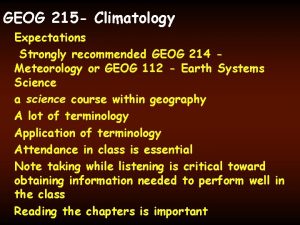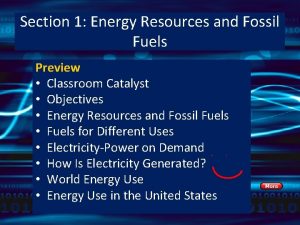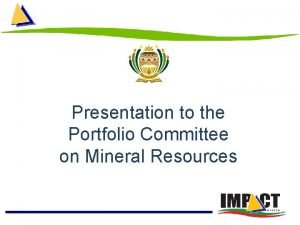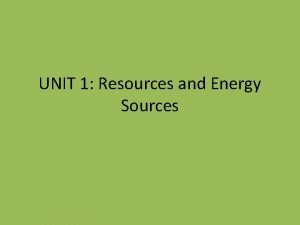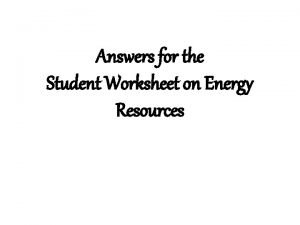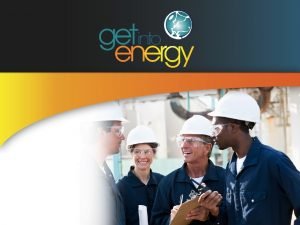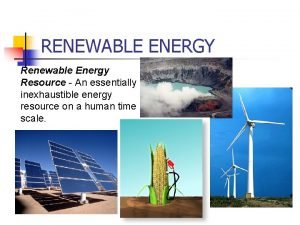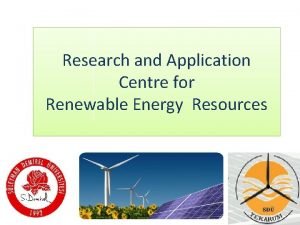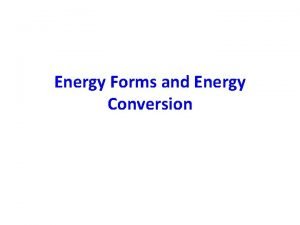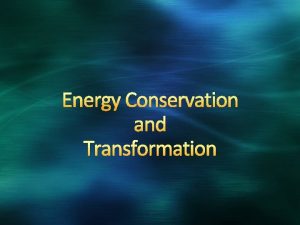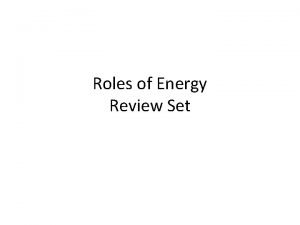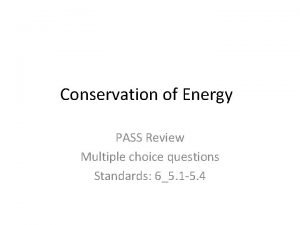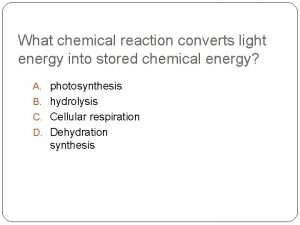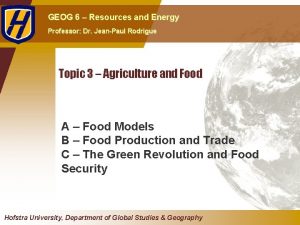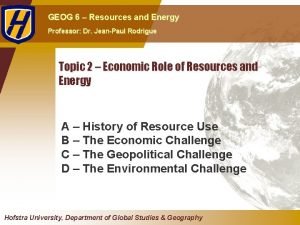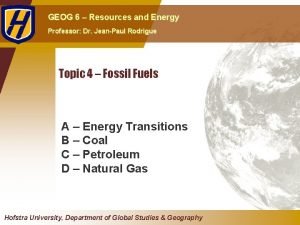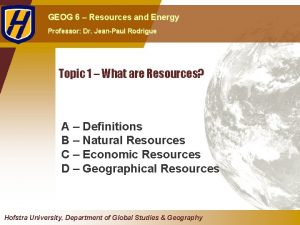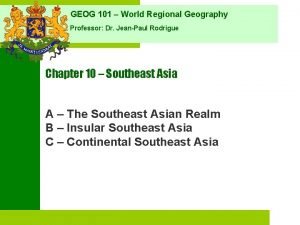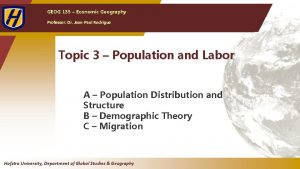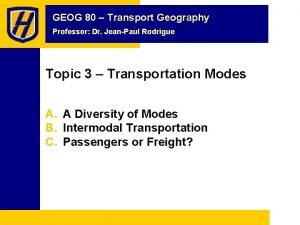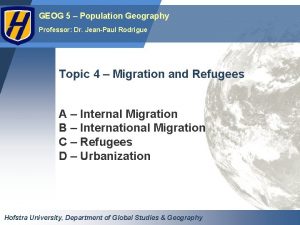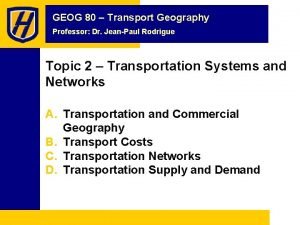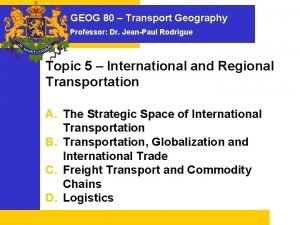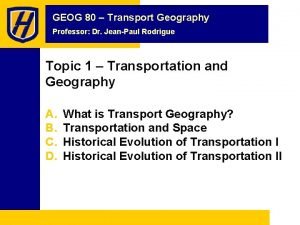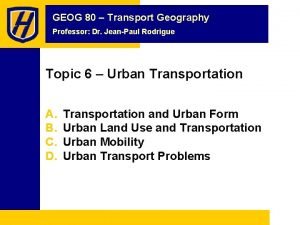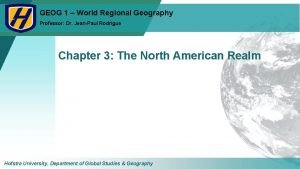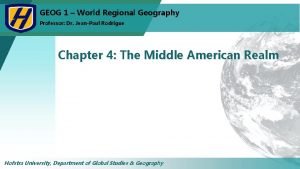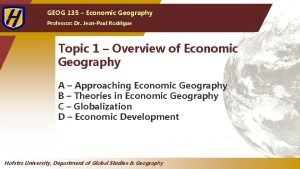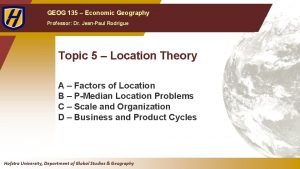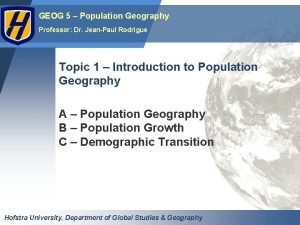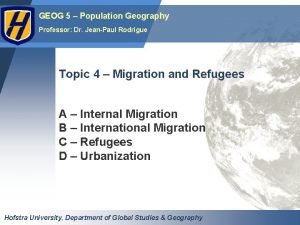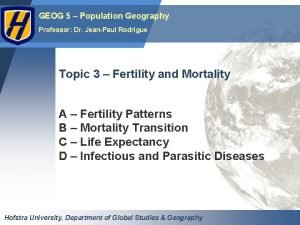GEOG 6 Resources and Energy Professor Dr JeanPaul

















































- Slides: 49

GEOG 6 – Resources and Energy Professor: Dr. Jean-Paul Rodrigue Topic 6 – Alternative Sources of Energy A – The Search for Options B – High Intensity Sources C – Low Intensity Sources Hofstra University, Department of Global Studies & Geography

A. THE SEARCH FOR OPTIONS 1. Emergence of Alternative Sources 2. Fuel Efficiency 3. The Dominance of the Automobile © Dr. Jean-Paul Rodrigu

1. Emergence of Alternative Sources ■ Alternative energy • Supplement / replace an energy source with a new source: • The existing energy source judged to be no longer sustainable. • New source judged more convenient than the previous, but comes with its own drawback. • Have always existed: • Wood to coal. • Whale oil to petroleum. • From non-renewable to renewable. • Received increasing attention since the first oil crisis in 1973: • Attention varies with fluctuations in the price of oil. • Since 2005, renewed attention because of a surge in oil © Dr. Jean-Paul Rodrigu prices (e. g. wind, solar).

1. Emergence of Alternative Sources ■ Stocks and flows • Stock: Existing capital accumulation. • Flows: The nature and extent of new capital investments. ■ Fossil fuels stocks • Dominate energy supply markets. • Dominance likely to remain on the years to come. ■ Alternative energy flows • Receiving a growing quantity of flows. • These will eventually expand the alternative energy stocks. © Dr. Jean-Paul Rodrigu

1. Global Carbon Dioxide Emissions from Fossil Fuel Burning by Fuel Type, 1900 -2009 4 000 Coal 3 500 3 000 Oil 2 500 2 000 1 500 1 000 0 1904 1908 1912 1916 1920 1924 1928 1932 1936 1940 1944 1948 1952 1956 1960 1964 1968 1972 1976 1980 1984 1988 1992 1996 2000 2004 2008 500 © Dr. Jean-Paul Rodrigu

1. Average Global Temperature and World Carbon Emissions From Fossil Fuel Burning, 1800 -2009 9 000 16 8 000 Million Tons of Carbon 14 7 000 12 6 000 10 5 000 8 4 000 6 3 000 4 2 000 2000 1990 1980 1970 1960 1950 1940 1930 1920 1910 1900 1890 1880 1870 1860 1850 1840 1830 0 1820 0 1810 2 1800 1 000 © Dr. Jean-Paul Rodrigu

2. Energy Efficiency ■ Transportation • Minimize traveling distances (commuting, leisure freight). • Improve fuel economy of vehicles. • Shift from petroleum. ■ Buildings • Temperature control systems (heating, cooling, ventilation). • Insulation. • Lighting and appliances. ■ Industry • Product life cycle. • Re-use and recycling. • Improve industrial processes. © Dr. Jean-Paul Rodrigu

2. Average Gasoline Consumption for New Vehicles, United States, 1972 -2009 (in miles per gallon) 35 30 Cars Light Trucks Average 25 20 15 19 72 19 74 19 76 19 78 19 80 19 82 19 84 19 86 19 88 19 90 19 92 19 94 19 96 19 98 20 00 20 02 20 04 20 06 20 08 10 © Dr. Jean-Paul Rodrigu

2. Light-Duty Vehicles Sales in the United States, 19752008 (in 1, 000 s) 18 000 Trucks 16 000 Cars 14 000 12 000 10 000 8 000 6 000 4 000 2 000 19 75 19 77 19 79 19 81 19 83 19 85 19 87 19 89 19 91 19 93 19 95 19 97 19 99 20 01 20 03 20 05 20 07 20 09 0 © Dr. Jean-Paul Rodrigu

2. Vehicle Sales, United States, 1931 -2009 12 000 10 Cars (Thousands) 9 10 000 8 Trucks (Thousands) 7 8 000 6 6 000 5 4 4 000 3 2 2 000 1 -1930 1940 1950 1960 1970 1980 1990 2000 0 2010 © Dr. Jean-Paul Rodrigu

2. Typical Energy Use for a Car 8% 12% Momentum 5% Exhaust 13% Cylinder cooling Engine friction 33% Transmission and axles Braking 29% © Dr. Jean-Paul Rodrigu

2. Alternative Sources of Energy for Transportation Source Advantages Drawbacks Biodiesel Renewable; biodegradable; domestically produced; improved lubricity in engine; reduced air pollutant emissions. May congeal at low temperatures; may damage engine components; lower fuel economy; non- renewable fuels are used in production; limited availability; may increase nitrous oxide emissions. Ethanol Renewable; domestically produced; may reduce harmful air pollutants. Non-renewable fossil fuels are used in its production; slightly decreases fuel economy. Natural gas / propane Reduced air pollutant emissions. Non-renewable fossil fuel; reduced driving range; limited availability; larger fuel tanks. Electricity Zero tailpipe emissions; widely available. High vehicle and battery costs; limited range and performance; electricity production mainly from non-renewable sources. Hybrid electric Increased fuel economy and reduced pollution; good range and performance Primarily fueled with non-renewable fossil fuels. Synthetic fuels Abundant supply exists. Significant environmental damages from extraction and processing; high carbon emissions; high production costs. Hydrogen Zero tailpipe emissions. Potential use of fossil fuels to produce; high cost of vehicle. © Dr. Jean-Paul Rodrigu

B. HIGH INTENSITY SOURCES 1. Hydrogen and Fuel Cells 2. Biomass © Dr. Jean-Paul Rodrigu

1. Hydrogen and Fuel Cells ■ Hydrogen • • • Considered to be the cleanest fuel. Compose 90% of the matter of the universe. Non polluting (combustion emits only water and heat). Highest level of energy content. Almost three times more than methane. ■ Nuclear fusion • Currently researched but without much success. • It offers unlimited potential. • Not realistically going to be a viable source of energy in the foreseeable future. © Dr. Jean-Paul Rodrigu

1. Hydrogen and Fuel Cells ■ Fuel cells Hydrogen Oxygen Fuel Cell Catalytic conversion Water Electricity • Convert fuel energy (such as hydrogen) to electric energy. • No combustion is involved. • Composed of an anode and a cathode. • Fuel is supplied to the anode. • Oxygen is supplied to the cathode. • Electrons are stripped from a reaction at the © Dr. Jean-Paul anode and attracted to Rodrigu

1. Hydrogen and Fuel Cells ■ Storage issues • Hydrogen is a highly combustive gas. • Find a way to safely store it, especially in a vehicle. ■ Delivery issues • • Distribution from producers to consumers. Production and storage facilities. Structures and methods for transporting hydrogen. Fueling stations for hydrogen-powered applications. © Dr. Jean-Paul Rodrigu

1. Hydrogen and Fuel Cells ■ Hydrogen production Fossil Fuels Steam Reforming Water Electrolysis • Not naturally occurring; secondary energy resources. • Producing sufficient quantities to satisfy the demand. • Extraction from fossil fuels: • From natural gas. • Steam reforming. • Electrolysis of water: Biomass Pyrolysis • Electricity from fossil fuels not a environmentally sound alternative. • Electricity from solar or wind energy is a better alternative. • Pyrolysis of the biomass: • Decomposing by heat in an oxygen-reduced atmosphere. © Dr. Jean-Paul Rodrigu

1. Hydrogen and Fuel Cells ■ Main potential uses • Transportation: • Most likely replacement for the internal combustion engine. • Efficiency levels are between 55% and 65%. • Stationary power stations: • Connected to the electric grid; supplemental power and backup. • Grid-independent generator. • Telecommunications: • Reliable power for telecom systems (e. g. cell phone towers, internet servers). • Micro Power: • For consumer electronics (e. g. cell phones and portable computers). © Dr. Jean-Paul Rodrigu

2. Biomass ■ Nature • Biomass energy involves the growing of crops for fuel rather than for food. • Crops can be burned directly to release heat or be converted to useable fuels such methane, ethanol, or hydrogen. • Has been around for many millennia. • Not been used as a large-scale energy source: • 14% of all energy used comes from biomass fuels. • 65% of all wood harvested is burned as a fuel. • 2. 4 billion people rely on primitive biomass for cooking and heating. • Important only in developing countries. • Asia and Africa: 75% of wood fuels use. • US: 5% comes from biomass sources. © Dr. Jean-Paul Rodrigu

2. Energy Consumption, Solid biomass (includes fuel wood) 2001 Mexico Myanmar France Philippines Canada Sudan Kenya Tanzania South Africa Thailand Congo, Dem Rep Ethiopia Viet Nam Pakistan Brazil Indonesia United States Nigeria India China 0 50000 100000 150000 200000 250000 © Dr. Jean-Paul Rodrigu

2. Global Biomass © Dr. Jean-Paul Rodrigu

2. Biomass ■ Biofuels • Fuel derived from organic matter. • Development of biomass conversion technologies: • Alcohols (ethanol) and methane the most useful. • First generation biofuels: • Food-based. • Plant materials like corn, starch or sugar from cane. • Second generation biofuels: • Cellulosic based. • Waste materials like plant stalks composed of cellulose. ■ Requirements for sustainable biomass use • Production of biomass through low input levels: • Labor, fuel, fertilizers and pesticides. • Production of biomass on low value land. • Low energy of conversion into biofuels. © Dr. Jean-Paul Rodrigu

2. Biomass Energy Sources Fuels Uses Forest products Wood, woodchips Direct burning or charcoal Agricultural residues Husks, shells, stems Direct burning Energy crops Sugarcane, corn Ethanol, gasification Trees Palm oil Biodiesel Animal residues Manure Methane Urban wastes Waste paper, organic wastes Direct burning, methane © Dr. Jean-Paul Rodrigu

2. Global Ethanol Production, 1975 -2009 (million gallons) 20 000 18 000 16 000 14 000 12 000 10 000 8 000 6 000 4 000 2 000 19 75 19 77 19 79 19 81 19 83 19 85 19 87 19 89 19 91 19 93 19 95 19 97 19 99 20 01 20 03 20 05 20 07 20 09 0 © Dr. Jean-Paul Rodrigu

2. Biomass ■ Potential and drawbacks • Competing with other agricultural products for land. • Could contribute to reducing carbon emissions while providing a cheap source of renewable energy: • Burning biofuels does create carbon emissions. • The burned biomass is that which removed carbon from the atmosphere through photosynthesis. • Does not represent a real increase in atmospheric carbon. • Genetic engineering: • Create plants that more efficiently capture solar energy. • Increasing leaf size and altering leaf orientation with regard to the sun. • Conversion technology research: • Seeking to enhance the efficiency rate of converting biomass into energy. • From the 20 -25% range up to 35 -45% range. © Dr. Jean-Paul Rodrigu

C. LOW INTENSITY SOURCES 1. Solar Energy 2. Wind Power 3. Geothermal Energy © Dr. Jean-Paul Rodrigu

1. Solar Energy ■ Definition • Radiant energy emitted by the sun. • Large amount of solar energy reaching the Earth’s surface. • 10 weeks of solar energy equivalent to all known fossil fuel reserves. ■ Advantages • • Widely available energy source. Limited environmental footprint. Limited maintenance. Affordable. ■ Drawbacks • Limitations in temporal availability (e. g. night). • Reconversion of existing facilities. © Dr. Jean-Paul Rodrigu

1. Solar Energy Level of insolation (latitude & precipitation) Solar cells Sun Mirrors Concentration Water Evaporation Conversion Steam Turbine Electricity © Dr. Jean-Paul Rodrigu

1. The Global Solar Energy Balance © Dr. Jean-Paul Rodrigu

1. Global Solar Energy Potential © Dr. Jean-Paul Rodrigu

1. Solar Energy ■ Photovoltaic systems • Semiconductors to convert solar radiation into electricity. • Better suited for limited uses that do not require large amounts of electricity. • Costs have declined substantially: • 9 -10 cents per kilowatt-hour. • Compared to about 3 -5 cents for coal fired electrical power. • Economies of scale could then be realized in production of the necessary equipment. • Roofs of buildings (e. g. warehouses) suitable locations to effectively install solar panels. © Dr. Jean-Paul Rodrigu

1. Photovoltaic System © Dr. Jean-Paul Rodrigu

1. World Photovoltaic Annual Production and Price 19752009 12 000 90 80 10 000 8 000 70 Production (Megawatts) 60 50 6 000 40 4 000 30 20 2 000 10 0 19 75 19 77 19 79 19 81 19 83 19 85 19 87 19 89 19 91 19 93 19 95 19 97 19 99 20 01 20 03 20 05 20 07 20 09 0 © Dr. Jean-Paul Rodrigu

1. Photovoltaic Production by Country or Region, 19952009 (Megawatts) 12 000 10 000 8 000 Others United States 6 000 Germany Taiwan 4 000 Japan China 2009 2008 2007 2006 2005 2004 2003 2002 2001 2000 1999 1998 1997 1996 0 1995 2 000 © Dr. Jean-Paul Rodrigu

Solar Energy Consumption (Terawatt-hours), 1990 -2011 50 45 40 35 China 30 Japan 25 Spain 20 Italy 15 Germany US 10 0 1991 1992 1993 1994 1995 1996 1997 1998 1999 2000 2001 2002 2003 2004 2005 2006 2007 2008 2009 2010 2011 5 © Dr. Jean-Paul Rodrigu

1. Solar Energy ■ Solar thermal systems • Parabolic reflectors to focus solar radiation onto water pipes: • Concentrating the sunlight 1000 times. • 212 -750 F (100 -400 C), Generating steam that then power turbines. • Require ample, direct, bright sunlight. • Drawback of the solar thermal systems is their dependence on direct sunshine, unlike the photovoltaic cells. ■ Limitations • • Inability to utilize solar energy effectively. A record of 25% efficiency rate reached in 2008. Low concentration of the resource. Need a very decentralized infrastructure to capture © Dr. Jean-Paul Rodrigu

1. Solar Thermal System © Dr. Jean-Paul Rodrigu

2. Wind Power Sun Heat Air Pressure differences Wind Major prevalent wind systems Wind mills Site suitability Fans Turbine Electricity © Dr. Jean-Paul Rodrigu

© Dr. Jean-Paul Rodrigu

2. Wind Power ■ Potential use • Growing efficiency of wind turbines. • 75% of the world’s usage is in Western Europe: • Provided electricity to some 28 million Europeans in 2002. • Germany, Denmark (18%) and the Netherlands. • New windfarms are located at sea along the coast: • The wind blows harder and more steadily. • Does not consume valuable land. • No protests against wind parks marring the landscape. • United States: • The USA could generate 25% of its energy needs from wind power by installing wind farms on just 1. 5% of the land. • North Dakota, Kansas, and Texas have enough harnessable wind energy to meet electricity needs for the whole country. © Dr. Jean-Paul Rodrigu

2. Wind Power • Farms are a good place to implement wind mills: • A quarter of a acre can earn about $2, 000 a year in royalties from wind electricity generation. • That same quarter of an acre can only generate $100 worth or corn. • Farmland could simultaneously be used for agriculture and energy generation. • Wind energy could be used to produce hydrogen. ■ Limitations • Extensive infrastructure and land requirements. • 1980: 40 cents per kwh. • 2001: 3 -4 cents per kwh. • Less reliable than other sources of energy. • Inexhaustible energy source that can supply both electricity and fuel. © Dr. Jean-Paul Rodrigu

2. Evolution of Wind Turbine Technology 6000 140 5000 120 100 4000 80 Rated capacity (k. W) 3000 60 2000 Rotor Diameter (m) 40 1000 20 0 0 19801985199019961999200020052008 © Dr. Jean-Paul Rodrigu

2. World Wind Energy Generating Capacity, 1980 -2009 (in megawatts) 180 000 160 000 140 000 Cumulative Installed Capacity Net Annual Addition 120 000 100 000 80 000 60 000 40 000 20 000 19 82 19 84 19 86 19 88 19 90 19 92 19 94 19 96 19 98 20 00 20 02 20 04 20 06 20 08 0 © Dr. Jean-Paul Rodrigu

2. Cumulative Installed Wind Power Capacity in Top Ten Countries and the World, 1980 -2011 (Megawatts) 70 000 60 000 U. S. 50 000 Germany 40 000 China Spain 30 000 India Italy 20 000 France U. K. 2010 2008 2006 2004 2002 2000 1998 1996 1994 1992 1990 1988 1986 1984 1982 0 1980 10 000 © Dr. Jean-Paul Rodrigu

2. Cumulative Installed Offshore Wind Power Capacity by Country, 2009 (Megawatts) Japan Norway China Ireland Finland Belgium Germany Sweden Netherlands Denmark United Kingdom 0 100 200 300 400 500 600 700 800 900 1000 © Dr. Jean-Paul Rodrigu

3. Geothermal Energy ■ Geothermal plants • 2 -4 miles below the earth's surface, rock temperature well above boiling point. • Some areas where the natural heat of the earth’s interior is much closer to the surface and can be more readily tapped. • Closely associated with tectonic activity. • Hydrogeothermal: • Taping the aquifer. • Fracturing the rocks, introducing cold water, and recovering the resulting hot water or steam which could power turbines and produce electricity. • Injection well: • In situations where there is no aquifers (hot dry plants). • Drilling a pipe to about 5, 000 meters (16, 000 feet). © Dr. Jean-Paul Rodrigu • Injecting a liquid (often water) through the pipe.

3. World Geothermal Power in Installed Capacity, 19502011 (in megawatts) 12000 10000 8000 6000 4000 2010 2007 2004 2001 1998 1995 1992 1989 1986 1983 1980 1977 1974 1971 1968 1965 1962 1959 1956 1953 0 1950 2000 © Dr. Jean-Paul Rodrigu

3. Geothermal Energy ■ Geothermal heat pumps Winter House 5 feet 55 o F Summer House • Promising alternative to heating/cooling systems. • Ground below the frost line (about 5 feet) is kept around 55 o. F year-round. • During winter: • The ground is warmer than the outside. • Heat can be pumped from the ground to the house. • During summer: • The ground is cooler than the outside. • Heat can be pumped from the house to the ground. 5 feet 55 o F © Dr. Jean-Paul Rodrigu

■ Renewable sources of energy are also dependent on non-renewable resources • Photovoltaic cells consume non-renewable resources. • Solar-thermal plants consume land water from aquifers (arid areas). • Geothermal power consumes water from aquifers. • Wind energy consumes land, concrete, steel and rare earths (gearboxes). • All energy supplies require distribution systems (electric wires) that consume land resources. • The term renewable energy is therefore misleading. © Dr. Jean-Paul Rodrigu
 Promotion from associate professor to professor
Promotion from associate professor to professor Unit 1 geog. of ga/ga’s beginnings
Unit 1 geog. of ga/ga’s beginnings Free floating subdivisions
Free floating subdivisions Natural hazards definition ap human geography
Natural hazards definition ap human geography Hkdse geography 2020
Hkdse geography 2020 Geog 214
Geog 214 Geog
Geog Operation transformation process
Operation transformation process Difference between fixed and variable resources
Difference between fixed and variable resources Energy energy transfer and general energy analysis
Energy energy transfer and general energy analysis Energy energy transfer and general energy analysis
Energy energy transfer and general energy analysis Renewable resources vs nonrenewable resources
Renewable resources vs nonrenewable resources Deposit
Deposit Portfolio committee on mineral resources and energy
Portfolio committee on mineral resources and energy Renewable resource def
Renewable resource def Energy resources worksheet answers
Energy resources worksheet answers Energy resources definition
Energy resources definition Chapter 12 nonrenewable energy resources
Chapter 12 nonrenewable energy resources Define renewable energy source
Define renewable energy source Biomass energy disadvantages
Biomass energy disadvantages Introduction about energy resources
Introduction about energy resources Section 2 describing energy worksheet answers
Section 2 describing energy worksheet answers Primary energy and secondary energy
Primary energy and secondary energy Disadvantages of conventional energy
Disadvantages of conventional energy Helmholtz free energy
Helmholtz free energy Renewable energy and energy efficiency partnership
Renewable energy and energy efficiency partnership Energie cinetique
Energie cinetique Mechanical energy conservation
Mechanical energy conservation Potential energy
Potential energy Conservation of mechanical energy
Conservation of mechanical energy Energy forms and energy conversions
Energy forms and energy conversions The professor's beloved equation full movie
The professor's beloved equation full movie Potential energy
Potential energy Gibbs free energy equation
Gibbs free energy equation Gibbs energy and equilibrium
Gibbs energy and equilibrium Efficiency equation
Efficiency equation How are thermal energy and temperature different
How are thermal energy and temperature different A hairdryer converts ____ energy into ____ energy.
A hairdryer converts ____ energy into ____ energy. Formula of energy
Formula of energy How to convert mechanical energy to electrical energy
How to convert mechanical energy to electrical energy Thermal energy section 3 using thermal energy
Thermal energy section 3 using thermal energy What is delta g
What is delta g As nutritional energy passes through the food chain it is
As nutritional energy passes through the food chain it is Usable chemical energy in food begins as __________ energy.
Usable chemical energy in food begins as __________ energy. Chapter 7 energy conservation of energy
Chapter 7 energy conservation of energy Wind power is an indirect form of solar energy
Wind power is an indirect form of solar energy ________ converts light energy into chemical energy. *
________ converts light energy into chemical energy. * Formula for total mechanical energy
Formula for total mechanical energy Definition of elastic potential energy
Definition of elastic potential energy Energy from electric field
Energy from electric field





